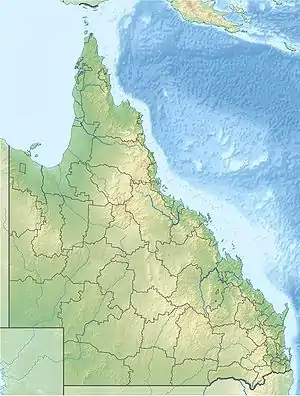Gregory River (Australia)
The Gregory River (Waanyi: Ngumarryina) is a river located in the Northern Territory and the state of Queensland, Australia. The river is the largest perennial river in arid and semi-arid Queensland,[2][3] one of the few permanently flowing rivers in the northwest of Queensland.
| Gregory | |
|---|---|
 Location of Gregory River mouth in Queensland | |
| Etymology | In honour of Augustus Gregory |
| Native name | Ngumarryina |
| Location | |
| Country | Australia |
| Territory and State | Northern Territory, Queensland |
| Physical characteristics | |
| Source | Barkly Tableland |
| • location | Northern Territory |
| • elevation | 263 m (863 ft) |
| Mouth | Nicholson River |
• location | southwest of Burketown, Queensland |
• coordinates | 17°53′52″S 139°17′06″E |
• elevation | 11 m (36 ft) |
| Length | 321 km (199 mi) |
| Basin size | 24,179 km2 (9,336 sq mi) |
| Basin features | |
| River system | Nicholson River catchment |
| [1] | |
Course and features
The headwaters of the river rise on the north-eastern section of the Barkly Tableland[4] in the Northern Territory, in an area of gently undulating downs country dominated by cattle stations. The river is fed by springs in shallow valleys[5] and it then flows eastwards through an area of well developed canyons in Queensland. The river is joined by one of its major tributaries, the O'Shanassy River, a little downstream of Riversleigh.[6] Another main tributary Lawn Hill Creek discharges into the Gregory further downstream of Gregory Downs. The Gregory discharges into the Nicholson River to the southwest of Burketown, having descended 252 metres (827 ft) over its 321-kilometre (199 mi) course.[1]
The river has a catchment area of approximately 24,179 square kilometres (9,336 sq mi) and is part of the 52,234 square kilometres (20,168 sq mi) Nicholson River catchment.[2] The area on the Barkly Tableland is made up of dissected limestone-dolomite slopes, canyons and plateaus.[2]
The river has a mean annual flow of 694 gigalitres (1.53×1011 imp gal; 1.83×1011 US gal) with minimum flow of 123 GL (2.7×1010 imp gal; 3.2×1010 US gal) recorded in 1984–85 and a maximum flow of 3,701 GL (8.14×1011 imp gal; 9.78×1011 US gal) recorded in 1973–74.[2] A number of wetlands of national significance are found within the catchment. These include the 26,639 hectares (65,826 acres) Gregory River wetland and the 298,888 hectares (738,568 acres) Thorntonia Aggregation.[2]
The river is surrounded by forested areas on the upper reaches, with riparian woodlands and open savannah on the plains. Grasslands are made up of Astrebla pectinate and Eulalia fulca that grow on the heavy grey pedocals. Fringing forest is made up of a mix of Corymbia papuana, Eucalyptus tectifica and Eucalyptus microtheca.[7]
History
The traditional owners of the river are the Waanyi Aboriginal people, who call the river Ngumarryina.[8]
In 1861, William Landsborough[9] came across it during his 1861 expedition to find the lost Burke and Wills expedition.[10] Landsborough found the river while traveling from Burketown and followed it all the way to the Barkly Tableland. He named it the Gregory River in honour of Augustus Gregory, at the time the Queensland Surveyor General and an explorer.
References
- "Map of Gregory River". Bonzle Digital Atlas of Australia. Archived from the original on 24 May 2018. Retrieved 2 June 2015.
- "Ecological Assessment of the Freshwater Wetlands in the Nicholson-Gregory Catchment, North-Western Queensland" (PDF). James Cook University. 1 July 2005. Archived (PDF) from the original on 21 July 2015. Retrieved 2 June 2015.
- "Gregory Downs". Queensland Government. Archived from the original on 4 June 2015. Retrieved 4 June 2015.
- Randal, M. A. (1967). "Groundwater in the Barkly Tableland, N.T." (PDF). Commonwealth of Australia. Archived (PDF) from the original on 22 December 2015. Retrieved 3 June 2015.
- "Barkly Tableland". Queensland Places. Archived from the original on 5 June 2015. Retrieved 4 June 2015.
- "Flood warning on the Nicholson River". Bureau of Meteorology. Archived from the original on 5 June 2015. Retrieved 4 June 2015.
- Christian, Noakes; et al. (1947). "Survey of the Barkly Region, Northern Territory and Queensland" (PDF). CSIRO. Archived (PDF) from the original on 22 December 2015. Retrieved 4 June 2015.
- Scambary, Benedict (2013). My Country, Mine Country: Indigenous People, Mining and Development Contestation in Remote Australia. ANU E Press.
- "Landsborough's Blazed Tree, Camp 69 (entry 602715)". Queensland Heritage Register. Queensland Heritage Council. Retrieved 15 August 2015.
- Trundle, Gwen (1974). "Landsborough, William (1825–1886)". Australian Dictionary of Biography. Australian National University. Archived from the original on 11 April 2015.